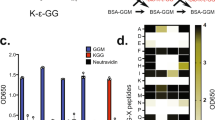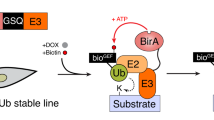Abstract
The post-translational modification of proteins with ubiquitin and ubiquitin-like proteins (Ubl) is vital to many cellular functions, and thus the identification of Ubl targets is key to understanding their function. In most cases, only a small proportion of the cellular pool of proteins is found conjugated to a particular Ubl, making identification of Ubl targets technically challenging. For the purposes of proteomic analyses, we have developed a protocol for the large-scale purification of Ubl-linked proteins that minimizes sample contamination with noncovalent interactors and prevents the cleavage of Ubl–substrate bonds catalyzed by Ubl-specific proteases. This is achieved by introducing a denaturing lysis step (in the presence of sodium dodecyl sulfate and alkylating agents that irreversibly inhibit Ubl proteases) before TAP (tandem affinity purification) that allows for efficient purification of putative Ubl-specific substrates in a form suitable for proteomic analysis. The timescale from cell lysis to purified protein sample is 5–6 d.
This is a preview of subscription content, access via your institution
Access options
Subscribe to this journal
Receive 12 print issues and online access
$259.00 per year
only $21.58 per issue
Buy this article
- Purchase on Springer Link
- Instant access to full article PDF
Prices may be subject to local taxes which are calculated during checkout


Similar content being viewed by others
References
Geiss-Friedlander, R. & Melchior, F. Concepts in sumoylation: a decade on. Nat. Rev. Mol. Cell Biol. 8, 947–956 (2007).
Girdwood, D.W., Tatham, M.H. & Hay, R.T. SUMO and transcriptional regulation. Semin. Cell Dev. Biol. 15, 201–210 (2004).
Hoege, C., Pfander, B., Moldovan, G.L., Pyrowolakis, G. & Jentsch, S. RAD6-dependent DNA repair is linked to modification of PCNA by ubiquitin and SUMO. Nature 419, 135–141 (2002).
Muller, S., Ledl, A. & Schmidt, D. SUMO: a regulator of gene expression and genome integrity. Oncogene 23, 1998–2008 (2004).
Pichler, A. & Melchior, F. Ubiquitin-related modifier SUMO1 and nucleocytoplasmic transport. Traffic 3, 381–387 (2002).
Stelter, P. & Ulrich, H.D. Control of spontaneous and damage-induced mutagenesis by SUMO and ubiquitin conjugation. Nature 425, 188–191 (2003).
Hay, R.T. Role of ubiquitin-like proteins in transcriptional regulation. Ernst Schering Res. Found. Workshop 173–192 (2006).
Herrmann, J., Lerman, L.O. & Lerman, A. Ubiquitin and ubiquitin-like proteins in protein regulation. Circ. Res. 100, 1276–1291 (2007).
Jentsch, S. & Pyrowolakis, G. Ubiquitin and its kin: how close are the family ties? Trends Cell Biol. 10, 335–342 (2000).
Bergink, S. & Jentsch, S. Principles of ubiquitin and SUMO modifications in DNA repair. Nature 458, 461–467 (2009).
Tagwerker, C. et al. A tandem affinity tag for two-step purification under fully denaturing conditions: application in ubiquitin profiling and protein complex identification combined with in vivo cross-linking. Mol. Cell Proteomics 5, 737–748 (2006).
Saitoh, H., Pu, R.T. & Dasso, M. SUMO-1: wrestling with a new ubiquitin-related modifier. Trends Biochem. Sci. 22, 374–376 (1997).
Hay, R.T. SUMO: a history of modification. Mol. Cell 18, 1–12 (2005).
Saitoh, H. & Hinchey, J. Functional heterogeneity of small ubiquitin-related protein modifiers SUMO-1 versus SUMO-2/3. J. Biol. Chem. 275, 6252–6258 (2000).
Golebiowski, F. et al. System-wide changes to SUMO modifications in response to heat shock. Sci. Signal 2, ra24 (2009).
Andersen, J.S., Matic, I. & Vertegaal, A.C. Identification of SUMO target proteins by quantitative proteomics. Methods Mol. Biol. 497, 19–31 (2009).
Rosas-Acosta, G., Russell, W.K., Deyrieux, A., Russell, D.H. & Wilson, V.G. A universal strategy for proteomic studies of SUMO and other ubiquitin-like modifiers. Mol. Cell Proteomics 4, 56–72 (2005).
Matic, I. et al. In vivo identification of human small ubiquitin-like modifier polymerization sites by high accuracy mass spectrometry and an in vitro to in vivo strategy. Mol. Cell Proteomics 7, 132–144 (2008).
Chung, T.L. et al. In vitro modification of human centromere protein CENP-C fragments by small ubiquitin-like modifier (SUMO) protein: definitive identification of the modification sites by tandem mass spectrometry analysis of the isopeptides. J. Biol. Chem. 279, 39653–39662 (2004).
Cooper, H.J. et al. Fourier transform ion cyclotron resonance mass spectrometry for the analysis of small ubiquitin-like modifier (SUMO) modification: identification of lysines in RanBP2 and SUMO targeted for modification during the E3 autoSUMOylation reaction. Anal. Chem. 77, 6310–6319 (2005).
Pedrioli, P.G. et al. Automated identification of SUMOylation sites using mass spectrometry and SUMmOn pattern recognition software. Nat. Methods 3, 533–539 (2006).
Zhao, Y., Kwon, S.W., Anselmo, A., Kaur, K. & White, M.A. Broad spectrum identification of cellular small ubiquitin-related modifier (SUMO) substrate proteins. J. Biol. Chem. 279, 20999–21002 (2004).
Li, T. et al. Sumoylation of heterogeneous nuclear ribonucleoproteins, zinc finger proteins, and nuclear pore complex proteins: a proteomic analysis. Proc. Natl. Acad. Sci. USA 101, 8551–8556 (2004).
Vertegaal, A.C. et al. A proteomic study of SUMO-2 target proteins. J. Biol. Chem. (2004).
Gregan, J. et al. Tandem affinity purification of functional TAP-tagged proteins from human cells. Nat. Protoc. 2, 1145–1151 (2007).
Puig, O. et al. The tandem affinity purification (TAP) method: a general procedure of protein complex purification. Methods 24, 218–229 (2001).
Rigaut, G. et al. A generic protein purification method for protein complex characterization and proteome exploration. Nat. Biotechnol. 17, 1030–1032 (1999).
Desterro, J.M., Rodriguez, M.S. & Hay, R.T. SUMO-1 modification of IkappaBalpha inhibits NF-kappaB activation. Mol. Cell 2, 233–239 (1998).
Shevchenko, A., Tomas, H., Havlis, J., Olsen, J.V. & Mann, M. In-gel digestion for mass spectrometric characterization of proteins and proteomes. Nat. Protoc. 1, 2856–2860 (2006).
Ong, S.E. & Mann, M. A practical recipe for stable isotope labeling by amino acids in cell culture (SILAC). Nat. Protoc. 1, 2650–2660 (2006).
Mann, M. Functional and quantitative proteomics using SILAC. Nat. Rev. Mol. Cell Biol. 7, 952–958 (2006).
Ong, S.E. et al. Stable isotope labeling by amino acids in cell culture, SILAC, as a simple and accurate approach to expression proteomics. Mol. Cell Proteomics 1, 376–386 (2002).
Schimmel, J. et al. The ubiquitin-proteasome system is a key component of the SUMO-2/3 cycle. Mol. Cell Proteomics 7, 2107–2122 (2008).
Xirodimas, D.P. Novel substrates and functions for the ubiquitin-like molecule NEDD8. Biochem. Soc. Trans. 36, 802–806 (2008).
Wisniewski, J.R., Zougman, A., Nagaraj, N. & Mann, M. Universal sample preparation method for proteome analysis. Nat. Methods 6, 359–362 (2009).
Ros, A. et al. Protein purification by off-gel electrophoresis. Proteomics 2, 151–156 (2002).
Nielsen, M.L. et al. Iodoacetamide-induced artifact mimics ubiquitination in mass spectrometry. Nat. Methods 5, 459–460 (2008).
Hobbs, S., Jitrapakdee, S. & Wallace, J.C. Development of a bicistronic vector driven by the human polypeptide chain elongation factor 1alpha promoter for creation of stable mammalian cell lines that express very high levels of recombinant proteins. Biochem. Biophys. Res. Commun. 252, 368–372 (1998).
Wang, M., You, J., Bemis, K.G., Tegeler, T.J. & Brown, D.P. Label-free mass spectrometry-based protein quantification technologies in proteomic analysis. Brief Funct. Genomic Proteomic 7, 329–339 (2008).
Ong, S.E., Foster, L.J. & Mann, M. Mass spectrometric-based approaches in quantitative proteomics. Methods 29, 124–130 (2003).
Ong, S.E. & Mann, M. Mass spectrometry-based proteomics turns quantitative. Nat. Chem. Biol. 1, 252–262 (2005).
Gygi, S.P. et al. Quantitative analysis of complex protein mixtures using isotope-coded affinity tags. Nat. Biotechnol. 17, 994–999 (1999).
Ishihama, Y., Rappsilber, J. & Mann, M. Modular stop and go extraction tips with stacked disks for parallel and multidimensional peptide fractionation in proteomics. J. Proteome Res. 5, 988–994 (2006).
Cox, J. et al. A practical guide to the MaxQuant computational platform for SILAC-based quantitative proteomics. Nat. Protoc. 4, 698–705 (2009).
Pan, C., Kumar, C., Bohl, S., Klingmueller, U. & Mann, M. Comparative proteomic phenotyping of cell lines and primary cells to assess preservation of cell type-specific functions. Mol. Cell Proteomics 8, 443–450 (2009).
Park, S.K., Venable, J.D., Xu, T. & Yates, J.R. III A quantitative analysis software tool for mass spectrometry-based proteomics. Nat. Methods 5, 319–322 (2008).
Acknowledgements
F.G. is supported by the Marie Curie Fellowship and Biotechnology and Biological Sciences Research Council. M.H.T. is supported by a Cancer Research UK program grant.
Author information
Authors and Affiliations
Contributions
F.G. and M.H.T. were responsible for optimization of the protocol's efficiency and specificity, as well as for its integration with quantitative proteomic applications. A.N. originally applied and modified the standard TAP procedure to facilitate purification of Ubl covalent conjugates. R.T.H. provided valuable advice and discussion.
Corresponding author
Ethics declarations
Competing interests
The authors declare no competing financial interests.
Rights and permissions
About this article
Cite this article
Golebiowski, F., Tatham, M., Nakamura, A. et al. High-stringency tandem affinity purification of proteins conjugated to ubiquitin-like moieties. Nat Protoc 5, 873–882 (2010). https://doi.org/10.1038/nprot.2010.40
Published:
Issue Date:
DOI: https://doi.org/10.1038/nprot.2010.40
This article is cited by
-
Identification and analysis of endogenous SUMO1 and SUMO2/3 targets in mammalian cells and tissues using monoclonal antibodies
Nature Protocols (2014)
-
Proteomics Strategies to Identify SUMO Targets and Acceptor Sites: A Survey of RNA-Binding Proteins SUMOylation
NeuroMolecular Medicine (2013)
-
The tandem affinity purification technology: an overview
Biotechnology Letters (2011)
Comments
By submitting a comment you agree to abide by our Terms and Community Guidelines. If you find something abusive or that does not comply with our terms or guidelines please flag it as inappropriate.



